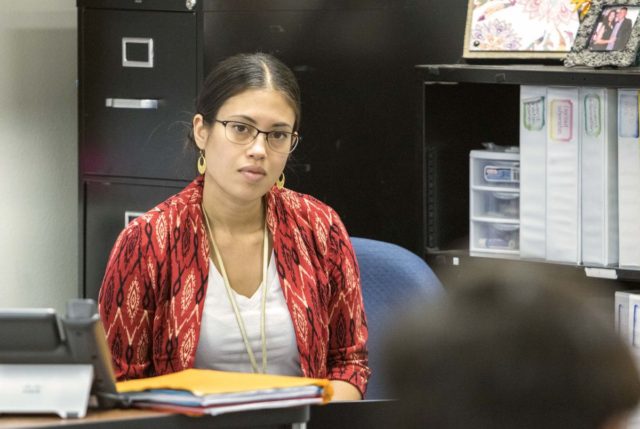Publisher’s NOTE: The ‘West Valley’ is incorporate of the western suburbs of Phoenix, Arizona. As we have previously published, Arizona is one of the states in this country, that has an intense shortage of teachers – but we are not the only state. What you are about to read is a more intense extension of the problem. ~ J.B.

West Valley View photo by Jordan Christopher
When Liza Lawson began teaching at La Joya Community High School in 2007, she was aware of the struggles new teachers typically faced.
She was prepared for the 85-hour work weeks, large class sizes and weekends spent tutoring or planning lessons. The burnout didn’t set in until years later.
“Going in, I knew that it was going to be a lot of work, but I had this expectation that the longer I taught, the less hours it would take for me to get things done,” Lawson said. “It was in my fifth year of teaching when I realized that I was working as many hours as I did when I started.”
Lawson is now a teacher mentor in the Tolleson Union High School District, and she supports those new to the field facing the same challenges.
“I experienced burnout when I was in the classroom,” she said. “When I came into this position four years ago, I had this horrible realization that my experience with burnout was not at all unusual.”
The “burnout” is one of many factors contributing to a teacher shortage that studies show is widespread throughout Arizona.
The personal finance website WalletHub analyzed 21 key metrics and ranked Arizona as the worst state in the nation for teachers. The report said the state ranked in the bottom five in public school funding per student, pupil-to-teacher ratio and projected teacher turnover. The study also estimated Arizona will have the lowest number of teachers per student by 2024.
ASU’s The Morrison Institute for Public Policy released an extensive study in May that found 42 percent of Arizona teachers hired in 2013 left the profession within three years.
That study, Finding & Keeping Educators for Arizona’s Classrooms, reported pay was a big factor. Arizona ranked last in the nation in elementary school teacher pay and 49th in high school teacher pay when both were adjusted for statewide cost of living.
Morrison Institute senior policy analyst Dan Hunting, the study’s principal researcher, said although pay was a significant issue contributing to the shortage, increased workload and a lack of support were also major factors.
“(Teachers) also feel oftentimes that they’re not adequately supported by their administration, either at the school or district level,” Hunting said. “A lot of districts, of course, are having to get very creative, because there’s not a lot of resources out there.”
Monica Sanders, director of human resources for Litchfield Elementary School District, said it’s becoming increasingly difficult to fill vacant positions.
“Teacher recruitment and retention is a year-round priority,” Sanders said.
She explained the district has four long-term substitute teachers because there is a lack of certified educators to fill those vacancies.
“This number is significantly smaller than what other districts are dealing with, but it’s still greater than we have ever experienced,” Sanders said.
In the Agua Fria Union High School District, officials have raised teachers’ salaries 8 percent in the past two years, according to Superintendent Dennis Runyan. But teacher turnover rates are high and it’s something the district continually works on.
Runyan sees an annual shortage in science and math teachers because the state does not have enough educator development programs. He added Arizona universities are doing a “wonderful job” prepping future teachers, but “the teacher pool, the pool from which you draw qualified candidates, is either very shallow or nonexistent in the state of Arizona.”
The Morrison Institute study found “Arizona is losing more teachers each year than it is producing from bachelor of education programs at its three state universities.”
Hunting’s research determined teachers are devoted to the profession, however.
“Even the people who I surveyed – the ones who said they were going to leave the profession within the next three years – a majority of those said that they liked their job,” Hunting said. “So teachers are very devoted to this profession, but it is just getting more and more difficult for them.”
Jon Byron is devoted to the profession. The Agua Fria High School government and economics teacher is in his 14th year. He said although education doesn’t seem to be a very high priority when it comes to state budgets and spending, he plans to remain a teacher.
“I chose this profession knowing exactly what it entails,” Byron said. “I love students. That’s what I’m here to do and that’s what’s keeping me in.”
According to Lawson, “teachers all enter the field with passion and drive, but without support and increasing effectiveness, they face burnout.”
Lawson said solving the teacher shortage problem will require members in all areas of the community to work together.
“I think another misconception about education is that it is simple and there will be a simple solution to some of the problems facing our students, teachers and schools,” Lawson said. “We need dynamic, diverse and creative solutions for our dynamic and diverse education system.”
Written by Derek Hall and published by the West Valley View ~ December 6, 2017.
 FAIR USE NOTICE: This site contains copyrighted material the use of which has not always been specifically authorized by the copyright owner. We are making such material available in our efforts to advance understanding of environmental, political, human rights, economic, democracy, scientific, and social justice issues, etc. We believe this constitutes a ‘fair use’ of any such copyrighted material as provided for in section 107 of the US Copyright Law. In accordance with Title 17 U. S. C. Section 107, the material on this site is distributed without profit to those who have expressed a prior interest in receiving the included information for research and educational purposes. For more information go to: http://www.law.cornell.edu/uscode/17/107.shtml
FAIR USE NOTICE: This site contains copyrighted material the use of which has not always been specifically authorized by the copyright owner. We are making such material available in our efforts to advance understanding of environmental, political, human rights, economic, democracy, scientific, and social justice issues, etc. We believe this constitutes a ‘fair use’ of any such copyrighted material as provided for in section 107 of the US Copyright Law. In accordance with Title 17 U. S. C. Section 107, the material on this site is distributed without profit to those who have expressed a prior interest in receiving the included information for research and educational purposes. For more information go to: http://www.law.cornell.edu/uscode/17/107.shtml
